Properties of galaxies
What's covered here:
- How do astronomers measure the various physical characteristics of galaxies?
- What is Hubble's Law all about?
- What influences the evolution of galaxies?
- What are galaxy clusters?
- What other galaxy groupings exist?
- What is dark matter?
Once astronomers started figuring out which objects were
and were not galaxies, they started to look for other properties of
galaxies that could be measured so they could compare their features and
try to discover how galaxies form, function and evolve. Not an easy task
given the great distances involved.
Galaxy Velocities
There are only certain things that can be observed with galaxies,
and one of those things is the spectrum of the galaxy. Now different
parts of a galaxy are moving in different directions and at different
speeds, so astronomers thought that there would just be a bunch of
random velocities observed in the spectrum, but that wasn't the case.
They started noticing that along with the random velocities there was an
overall general motion of entire galaxies through space. This would be
sort of like watching how people move on a jet plane. If you looked at
any given time there would be people moving up and down the aisles (and
waiting with crossed legs to use the bathrooms), but if someone were to
ask you how fast those people were actually moving, you would say
something like a couple of hundreds of miles an hour. Their small
individual motions are pretty measly compared to the plane's velocity -
the same is true with galaxies. They can have some fairly high
velocities involving the stuff within them but those velocities can be
pretty small compared to the overall motion of the galaxy through space.
Here's the weird thing - when you look at thousands of galaxies, you
see pretty much one type of motion - and that is motion away from us. It
looks like pretty much every distant galaxy out there is moving away
from us! All of their spectra show large redshifts (remember, velocity
away from an observer shifts the spectral features to longer, or redder,
wavelengths). Now not every single galaxy has a redshifted spectrum, but
the number of blueshifted spectra seen in galaxies is pretty sparse, and
that is mainly for galaxies that are near us. Apart from these few
galaxies, pretty much all the others are moving away from us.
Now this is a really bizarre thing - but what does it mean, and what
does it tell us about galaxies and the Universe? Just measuring the
spectra and getting the velocities is only one part of the answer. It
took some careful detective work to find the other piece of information
to figure out what was going on, and that piece of information had to do
with the distances of the galaxies. One fellow noticed that there was
actually a trend in the velocity values with the distance values. That
fellow was Edwin Hubble; you
remember him, the guy who figured out that galaxies were separate,
distant objects. He used his methods of obtaining distances to galaxies
(by using Standard Candles) and
combined that information with velocity data (obtained from the spectra
of galaxies). Just how did he combine that data? - in a graph, of
course.
If you plot up this data, you find that the greater the distance a
galaxy is from us, the faster it is moving away from us. Put another
way, distant galaxies are receding
from us at great speeds. The greater the distance, the greater
the speed away from us. This diagram, which was first constructed by Edwin
Hubble is known, surprisingly, as a Hubble
Diagram.
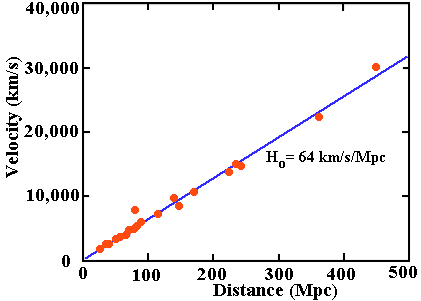 Figure 1. A Hubble Diagram, simply a plot of galaxy
velocity versus galaxy distance. This diagram is based upon distances
found using Supernovae. The slope of the line gives the value for the
Hubble Constant, Ho. Data from Riess, Press and Kirshner (1996).
Figure 1. A Hubble Diagram, simply a plot of galaxy
velocity versus galaxy distance. This diagram is based upon distances
found using Supernovae. The slope of the line gives the value for the
Hubble Constant, Ho. Data from Riess, Press and Kirshner (1996).
Now this diagram will only work on distant galaxies - nearby
galaxies don't show this sort of trend since they are moving randomly
around in their clusters - sometimes toward and sometimes away from us.
For distant galaxies there is a direct correlation between the speed a
galaxy is moving away from us and how far away it is from us. There must
be a formula that relates these two things, distance and velocity. Of
course there is! The data appear to fall along a straight line that can
be drawn through the data, so the line represents the slope of the
formula, and it can relate the two quantities. Guess what we call this
formula? You guessed it; it's known as the Hubble Law.
Mathematically, the formula is written out as
v = Hod
where, v=velocity (in km/s), d=distance (in Mpc), and Ho is
the slope of the formula and appears to be a constant, which we'll call
the Goober constant - no, that's silly, we better stick with the trend
here and call it the Hubble constant (its units are km/s/Mpc).
This is a pretty simple formula, eh?
Not only is this formula pretty simple, but is probably one of the
most important formulas ever written. THIS IS REALLY, REALLY
GREAT!!!! Why? There are three reasons.
1. If you remember the discussion of Standard Candles, you know that
there are some problems in finding accurate distances. The Hubble Law
provides astronomers with another method for finding distances - so long
as you know what the value of Ho is. How do we get Ho?
You need data from galaxies, in particular their distances and
velocities. Just take this data and plot it up like Hubble did, draw a
line through it and you'll get a value for the Hubble Constant, since it
is equal to the slope of the line. That sounds easy; get velocities and
distances of galaxies so we can use the Hubble Law to find distances to
galaxies. Wait a minute, if we want to use
the Hubble Law to determine distances, we need to first have distances to determine what Ho
is before we can use it to find distances - that's silly. This doesn't
make sense. How can we find distances with the Hubble Law if we first
need to have distances to get the constant? That's sort of the problem
with the whole thing.
Astronomers can try many times to determine the value of the Hubble
Constant using distances measured with Standard Candles and velocities
obtained from galaxy spectra, but they rarely get the same value for the
constant. This has been one of the biggest problems in astronomy since
Hubble first did this in 1929. Each time someone tries to determine the value of
the Hubble constant, they get a value that doesn't agree with anyone
else's value, so there has usually not been much agreement on what value
to use for the Hubble Constant. One of the reasons that astronomers
don't agree with one another about the value for the Hubble Constant is
that they use different methods or assumptions in getting distances, so
they will get different values for Ho. Astronomers who do
this experiment over and over even change their own ideas as to what
the value of Ho is.
That's just dandy; how are we supposed to know what the value of the
Hubble Constant is? Actually, things have gotten better since around 1999.
Astronomers using the Hubble Telescope (which was
not built by Edwin Hubble, it was just named for him) were able to
measure distances using Cepheids and Supernovae in distant galaxies.
Actually, several different groups of astronomers were doing this, so of
course they ended up with slightly different values of the Hubble Constant.
However when you look at all of the data it tends to converge to a value
of around 70
km/s/Mpc. This is actually pretty good; it used to be that the
values for the Hubble Constant that people calculated were widely
divergent by large amounts. Typically, if you wanted to use the Hubble
Law to get distances, you would pick a reasonable value based upon
a project that measures it accurately, usually something between 65 and 75
km/s/Mpc. While the actual, precise value of the Hubble constant will never be
known, if you used a value such as 70 km/s/Mpc, you wouldn't upset too many people.
It is sort of a good thing that the Hubble Telescope was able to do
what it was built for, namely to help figure out what the value for the
Hubble Constant is fairly accurately. Now it's onto another reason why
the Hubble Law is so cool.
2. What exactly is Ho? What does it represent?
According to the Hubble Law, Ho=Velocity/Distance. So what is
Velocity dependent upon? It is basically Distance/Time. Therefore
Ho = (Distance/Time)/Distance = 1/Time.
It is related to a time. What does this time represent? The time value
which Ho represents is the time it took for the Universe to
expand to its current size, or another way of saying it is that it is a
rough estimate for the age of the Universe - good gravy, that's one of
those basic questions of life, the universe and everything. That's sort
of an important number - not as important as your student ID number or
your weight, but it is one of those numbers that have been on people's
minds for a long time.
3. The last reason why the Hubble Law is so valuable is why it even
exists at all. That's a rather interesting thing - why does it exist?
Why are those more distant galaxies moving away from us at greater
velocities? The Hubble Law exists because of what the Universe is doing
- it is Expanding! If the Universe weren't expanding or
moving in some way, there would be no trend in the velocities. Hubble
wouldn't have been able to make that nifty plot of his if the Universe
were sitting still. We'll look at this aspect more closely later.
The Hubble Constant is a pretty important thing. Why can't we figure
out what its value is simply? It is easy, isn't it? No, it is not easy
at all, but is a rather complex step-by-step process. There are many
places to mess up in the process.
To determine the scale of the Universe, you must first start closer at
home. You need to determine the distance to the Sun, the AU. Why? The
concept of parallax is based upon our orbit about the Sun, so the size
of a parsec depends upon the size of the AU. Once we know how big an AU
is, you can start to find the distances to nearby stars (using the
parallax method), then the distances to more distant stars (using the
properties of the nearby stars and methods such as spectroscopic
parallax), then the distances to nearby galaxies (using various Standard
Candles, which are based upon the characteristics of those stars that
you looked at previously in your own galaxy), then the distances to more
distant galaxies (using the characteristics of the nearby galaxies) and
so on.
As you go further out, more assumptions, more uncertainties, more
inconsistencies between various scientists, more guess work, and more
shaky ground pops up. No wonder those silly astronomers can't agree;
it's too much of a mess to begin with!!!!
Galaxy Masses and Luminosities
Two things that we like to measure with stars are
mass and luminosity, and this is also true with galaxies. Let's see how
that is done, shall we? Unfortunately, with galaxies being so far away,
it isn't always possible to determine their masses accurately. There
are a few special situations where the mass can be determined, though,
and these are done by using methods you've already seen before - by
looking at how quickly a galaxy rotates and by looking at the motion of
binary galaxies.
The first method, using the rotation of the galaxy, is the same way
that we determine the mass of the Milky Way. If you measure the speed of
rotation (from the galaxy's spectrum) of a distant part of a galaxy,
you can then use Kepler's laws to figure out how much mass is located
within the orbit of that distant part. There are a few problems with
this method, mainly that it really only works well for spiral galaxies,
so it can't be used for all types of galaxies. You also want to have the
galaxy tilted so that the velocity is directly toward/away from us. If
the galaxy is tilted at a random angle relative to our view, we have to
take that into account when figuring out the velocity and therefore the
mass of the galaxy, so it is always better to have direct motion toward
or away from us. We also have to take into account the overall velocity
of the galaxy through space. Once we do that we see that spiral galaxies
rotate pretty much like the Milky Way does - and this supports our
observations of our own galaxy.
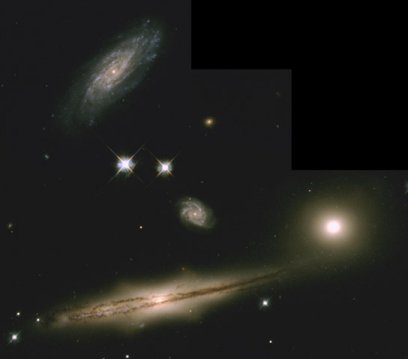 Figure 2. Several
galaxies in a group. The motions of these galaxies about one another
can help determine their masses. Image Credit: Hubble Heritage Team
(STScI/AURA/NASA).
Figure 2. Several
galaxies in a group. The motions of these galaxies about one another
can help determine their masses. Image Credit: Hubble Heritage Team
(STScI/AURA/NASA).
The other method used to figure out the mass of a galaxy is to
observe a binary galaxy system. This is just like using binary stars to
determine the masses of stars. There is only one small problem. Galaxies
are like giant lumbering elephants - they don't appear to move very
fast as we see them. This is in part due to their great distances. If a
jet plane were 30 feet from you and it went by it would obviously look
like it was moving fast, but when it is 30,000 feet up it appears to be
just inching along. It isn't actually going at a slower speed,
but the apparent distance it covers looks to be less since it is further
away from you. Now extend this to galaxies. These beasts can be moving
at hundreds of kilometers per second around each other, but because
they are so far away you never see any visible motion in your lifetime.
Even if you live to be 100 years old, you won't see any motion. Even
though we can't see the motion, we can still get a clue as to how fast
they are moving based upon how their spectra are screwed up by the
Doppler effect. There is a problem with this. The Doppler effect only
measures velocities toward or away from you, not velocities that are
side-ways. No matter how long you look or how carefully you analyze the
spectra, you'll never accurately measure the entire velocity of a pair
of binary galaxies. Often astronomers have to guess about the amount of
velocity they are missing. I suppose I should not say guess, since that
sounds like we're throwing darts at a board and using those numbers. We
really don't do that, but instead use various statistics to figure out
how much of the velocity we are missing.
Any ways, after we estimate the velocities and the separation of the
binary galaxies, we can get their masses using Kepler's Third law, just
like with binary stars -
M1+M2 = a3/P2
where M1 and M2 are the masses of the galaxies and a
and P have their usual meaning. As with binary stars, the masses
are in solar masses, the distance is in A.U.s and the period is in
years. Isn't that nifty? Kepler's simple little law works for more than
just planets; it works for whole galaxies!!! You probably didn't think
I'd get this much mileage out of that one silly little law did you?
Actually, you could even use this method to get not only the mass of
two galaxies going about one another, but of a whole bunch of galaxies
going about each other. All of their masses are influences on one
another, so they would all feel one another's pulls and would all obey
Kepler's Third law, but in this case one of the M values in the formula
is the mass of the whole group of galaxies.
Figuring out the luminosity of a galaxy is pretty tricky, since
sometimes it is difficult to figure out where the end of a galaxy is.
Longer and longer exposure pictures of galaxies (spiral galaxies
especially) show larger and larger sizes and more and more stuff. Just
where does a galaxy end? At some point astronomers have to say enough is
enough; we'll only measure out to a certain distance and add up all the
light to this distance. Then the guessing game is played again - how
much light are they missing by not seeing the stuff beyond this point?
How much light are they missing that is covered up by dust and gas
within our galaxy or by the dust and gas within the galaxy they are
looking at? What about the light sources that produce only IR or UV
light? There are quite a few fudge-factors that come into play in
luminosity estimates for galaxies because of the limitations we run
into. Typically, we measure galaxy luminosities in terms of the Sun's
luminosity.
In spite of all of these problems, once the mass of a galaxy is
known, it can be compared to the luminosity of the galaxy. Why? You know
that astronomers like to do weird things with numbers. Actually, we
just don't compare these numbers; we divide them. This gives us the M/L ratio - Mass to Luminosity ratio.
This is sort of an important thing. What if galaxies are made up
of average stars that are like the Sun? If that were the case, you'd expect to measure
the same amount of mass as you would luminosity from the galaxy, so the
M/L value should be close to one. What if a galaxy is ultra luminous or
abnormally bright for the amount of mass contained within it? If that
were the case, there
will be a large L value compared to the M value, so M/L would be low
(much less than one). The third possibility is if there is a ton of
material but it is really dark and not giving off much light, so there
would be a huge amount of M but not so much L, and then we would have a
large M/L value (much larger than one).
That's all fine and dandy, but what do we see for the M/L values of
galaxies? For spirals, the M/L value is about 35, and for ellipticals,
the M/L is about 70! What does this mean? It tells us that there is a
great deal of dim stuff in galaxies - it makes up a lot of mass but
doesn't show up in our telescopes (doesn't produce much light). This
means we are missing out on seeing a lot of the stuff that is out there.
Remember, the only way we can see stuff is if it produces light, and
with such high M/L values, we know that we are missing a lot of stuff.
It is sort of hard to determine the distribution of the different types
of galaxies, such as determining how many ellipticals, spirals, and
irregulars there are. The problem is that at great distances, the really
small galaxies would escape detection. Even if there were many small
galaxies (like dwarf ellipticals, dwarf spheroidals or small irregulars),
we would have a hard
time seeing all of them. Some astronomers say there are more
irregulars, while others believe that there are more ellipticals
(especially the dwarf ellipticals and spheroidals). We'll need more information before
we can settle this debate. Where have I heard that phrase before?
Galaxy Evolution
You've seen that there is quite a wide variety of galaxy types and that
the content, sizes, shapes and masses of galaxies are very diverse. Is
there any link between the various types? For example, if a galaxy
observed today is an SBc, will it always be an SBc or can it change into
an Sc, SBb, or whatever? How does a galaxy end up being a spiral, an
elliptical or an irregular? What determines these things? Why is it
that someone always calls you just when you're ready to sit down to
eat dinner? Oh, I guess this last question really has nothing to do
with galaxies.
Let's tackle the easiest parts first. We know that ellipticals have
sort of spherical blobby shapes and no new star formation in them. This
means that they made their stars very early in their lives and then that
was it - no more star formation - sort of a like a kid who eats all of
their Halloween candy at one time. They end up rather blobby and
spherical. Spiral galaxies, on the other hand, are still making stars,
so they didn't use up all their gas when they formed. They are like the
kid that slowly rationed out the candy, eating only a little at a time
so that it lasts longer. Why would they do either of these things -
using up all their gas or rationing it out? What could be the reason for
different galaxies to act in different ways?
One of the simplest explanations is to look at how a galaxy moves. An
elliptical galaxy has all of the material moving in a swarm about the
center, while a spiral has a well organized disk that is rotating. Why
are they different? One of the reasons that things may move the ways
they do is angular momentum.
You'll remember this was the thing that makes the ice skater spin faster
when the arms are brought in. Angular momentum also has some say in how
things will move and how fast they will move. If an object, like pizza
dough, is spinning really fast, it will tend to flatten out in a disk
as gravity pulls the material in. It is thought that this is what was
happening with spirals, that they were spinning pretty fast when they
formed, so that the gas didn't all blob together in the middle but got
spread out into a disk. If the gas is spread out it isn't going to go into making
stars immediately (remember, you have to compress it to a certain
degree). Elliptical galaxies, on the other hand, may have originally
been slow spinners, so they didn't flatten out, and the gas just
globbed together quickly (due to gravity) and formed all the stars
right away. If this idea about how they rotate is correct, then we
would expect to see more elliptical galaxies forming before spirals
forming, since the ellipticals' star formation isn't delayed. We do
actually see this. At great distances we see many well formed
elliptical galaxies but very few fully formed spirals - they are taking
their sweet time to form. As we'll see later, having ellipticals form
quickly can have some interesting consequences, especially when it
comes to their cores (or more precisely, what forms in their cores -
but I don't want to give that away).
Let's get to some specifics of the life cycle of a spiral. It is now
thought that spiral galaxies can change quite a bit over their lives by
having bars form in them and then having these bars dissipate over time.
The bar can redistribute the material in the disk and the bulge over
time and alter the rate of star formation, the chemical composition and
the galaxy type. Other things can also alter the shape of a spiral,
such as having another galaxy get a little too close to it and
re-arrange the material. It is possible for a galaxy to form as a type
Sc, become an SBc, then an SBb, then an Sb and then an Sa through
various processes. Of course, these changes will take millions or
billions of years to occur, but they can happen nonetheless. At this time
is not entirely clear how the shape of a galaxy will change over time since
both internal and external factors can play a role.
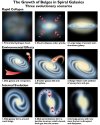 Figure 3. Click on this icon to see several
examples of how a galaxy can change. The rate at which it collapses,
interactions with other objects or the influence of a bar can all play
a role in altering the shape or content of a galaxy.
Figure 3. Click on this icon to see several
examples of how a galaxy can change. The rate at which it collapses,
interactions with other objects or the influence of a bar can all play
a role in altering the shape or content of a galaxy.
Irregular galaxies tend to be produced by collisions or
near-collisions of galaxies. The strong gravitational pull of big
galaxies on little galaxies can cause the material in the little
galaxies to be completely stripped off or re-arranged in a bizarre
shape. There are also cases where the little galaxy can screw up the
big galaxy - no one is immune from the forces of gravity; it just
depends upon how things come together and mess up one another. Our own
galaxy is going to collide with the Andromeda galaxy in about two
billion years. A simulation showing how that may look to someone
located far away is provided here (animation
visualization by Frank Summers (Space Telescope Science Institute).
Simulation by Chris Mihos (Case Western Reserve University) and Lars
Hernquist (Harvard University). Since this collision will start
before the Sun dies, it could result in our solar system being
flung out of the galaxy. When the collision finally finishes (in about
5 billion years) and
everything settles down, the Sun (and the planets) could be located
far from the center of the newly merged galaxy, possibly in the outer
halo of the newly formed galaxy. Or it could be found amongst the
other stars in the newly merged elliptical galaxy. Either way, it's
something we can look forward to.
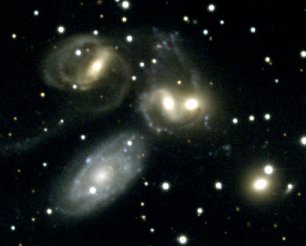 Figure 4. An
image of a group of galaxies known as Stephan's Quintet. These galaxies
are interacting with one another. If you click here,
you can see a computer simulation showing how these galaxies are
possibly moving and interacting. Image credit: N.A.Sharp/NOAO/AURA/NSF.
Animation credit: Credit: Joshua Barnes (University of Hawaii).
Figure 4. An
image of a group of galaxies known as Stephan's Quintet. These galaxies
are interacting with one another. If you click here,
you can see a computer simulation showing how these galaxies are
possibly moving and interacting. Image credit: N.A.Sharp/NOAO/AURA/NSF.
Animation credit: Credit: Joshua Barnes (University of Hawaii).
The giant elliptical galaxies (cD types) are thought to be produced
by cannibalism, and this idea tends to gain favor because there are
often remains of the "victim" galaxies still visible in the cores of
the cD galaxies. When you look at the locations of cD galaxies in
groups of other galaxies, they tend to be right in the middle, just
like a big, fat spider in the middle of a web. It doesn't necessarily
mean that the cD galaxy will eat up all of its neighbor galaxies, but
if something does get too close, it better watch out.
Galaxy Clusters
Once people realized galaxies are objects outside of our own galaxy,
they noticed that galaxies are not randomly scattered across the
Universe. They tend to be found in groups or clusters - what an original name!
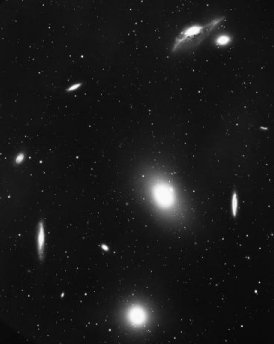 Figure 5. A
typical galaxy cluster, in this case the Virgo cluster. This one is
rather large having a few thousand galaxies in it. Only the brightest
are visible here. Image courtesy of NOAO/AURA/NSF.
Figure 5. A
typical galaxy cluster, in this case the Virgo cluster. This one is
rather large having a few thousand galaxies in it. Only the brightest
are visible here. Image courtesy of NOAO/AURA/NSF.
Our own galaxy is in such a cluster known as the Local Group. This contains around 70
galaxies with the big ones being our own Milky Way, the Andromeda
Galaxy (M31), and the Triangulum Galaxy (M33). There are many smaller
galaxies including the Large and Small Magellanic Clouds, the little
ellipticals that hang around Andromeda and a bunch of others. Actually,
the little galaxies (irregulars and dwarf ellipticals) outnumber the
big galaxies by a wide margin. The extent (diameter) of our cluster is
only around 1 million pc. It is such a pain to write out all of those
zeros that we'll just define a new unit of measure called the Megaparsec (Mpc), which is a million
parsecs. There is also the unit of a Megalightyear,
which is obviously a million lightyears. These two units are often used
to describe distances to galaxies or the sizes of galaxy clusters.
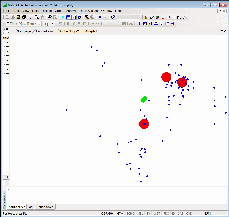 Figure 6. The Local Group seen in three dimensions.
If you click on the image you can see how the members of the Local
Group are spread out. The Milky Way is the large red dot in the center, while
the other two major galaxies, Andromeda and Triangulum, are the other two
red dots. The Large and Small Magellanic clouds are the green dots. All of
the other dots are dwarf elliptical, spheroidal or irregular galaxies. Sizes
of galaxies are not to scale.
Figure 6. The Local Group seen in three dimensions.
If you click on the image you can see how the members of the Local
Group are spread out. The Milky Way is the large red dot in the center, while
the other two major galaxies, Andromeda and Triangulum, are the other two
red dots. The Large and Small Magellanic clouds are the green dots. All of
the other dots are dwarf elliptical, spheroidal or irregular galaxies. Sizes
of galaxies are not to scale.
While you might think that the Local Group is pretty good sized,
there are actually other clusters that are larger, and I mean much
larger. Some clusters have a great number of galaxies and cover a
correspondingly larger span of the Universe than our little Local Group.
Clusters can contain thousands of galaxies spread over dozens of
Mpcs. Generally, clusters are distinguished mainly by their size. Those
with a lot of galaxies are termed as Rich,
while those with few galaxies are known as Poor.
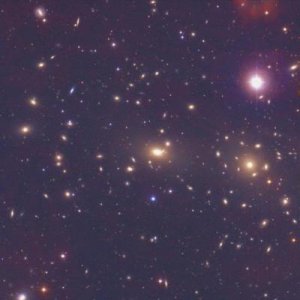 Figure 7. The Coma Cluster of galaxies. This picture
shows hundreds of galaxies. Nearly every object in this picture is a
galaxy - only a few of the objects are stars located in our own galaxy.
This is clearly a rich cluster. Image credit: Omar Lopez-Cruz & Ian
Shelton/NOAO/AURA/NSF.
Figure 7. The Coma Cluster of galaxies. This picture
shows hundreds of galaxies. Nearly every object in this picture is a
galaxy - only a few of the objects are stars located in our own galaxy.
This is clearly a rich cluster. Image credit: Omar Lopez-Cruz & Ian
Shelton/NOAO/AURA/NSF.
Clusters are the way they are because of gravity. One of the
effects of gravity is to bring some of the galaxies into close
proximity, which can lead to galaxy collisions or mergers. Astronomers
find that there are many collisions going on, or have gone on in the past.
In some clusters collisions can be on-going or happen every few billion
years. In the end the galaxies in the cluster could all merge into one
large central galaxy - usually an elliptical. But that would take a
very long time. You can see a simulation of a galaxy cluster's motion
here - this simulation spans nearly the
entire history of the Universe, around 14 billion years.
Based upon the ages of stars in them, we know that galaxies have been around
for billions of years and they are moving around in clusters at pretty
good speeds, yet the clusters stay together - the galaxies don't generally drift
or fly away. They are gravitationally bound systems - the galaxies are
orbiting about one another and stay together due to their mutual
gravitational attraction. If we can determine how fast the galaxies are
going then we can figure out how much mass is needed to keep them in a
group - how much gravity is needed to counteract their outward velocity. This
is another way of measuring the masses of galaxies, or even the masses
of a whole group of galaxies at once.
If you remember back to the discussion of galaxy masses and
luminosities, it seemed that we always detected more mass than light
from galaxies. Is this the result we get when we look at a whole bunch
of galaxies? Yes! When we look at whole clusters of galaxies, we tend to
see much less material than there needs to be to hold the group
together, or putting it another way, there is a very high M/L ratio. I'm
really getting sick of this high M/L thing - why do we always detect
more mass than we can see? Perhaps we're just using the wrong types of
telescopes? Perhaps a lot of the matter in galaxies and clusters of
galaxies is only visible at IR, UV or radio wavelengths? I'm sorry to
say that's not the answer. We've tried to look for the material at
these wavelengths and we still don't see enough stuff to account for
all of the mass that is in the galaxy clusters or the individual
galaxies. We just aren't seeing the stuff at all! Now things are going
to get a little silly. It appears that a large fraction of the stuff in
galaxies or even galaxy clusters is not visible to any telescope. We're
basically saying that we have a hard time seeing most of the material
that makes up even our own galaxy. What could this stuff be? This
is that same sort of thing we saw with the Milky Way Galaxy, the
presence of a large amount of unseen material. If you remember, we
refer to this stuff as dark matter - sort of a cool name,
don't you think? Dark matter comprises 90% or more of the total mass of
a cluster of galaxies. That means when astronomers look at groups of
galaxies, or even our own galaxy, they can only see 10% of the stuff
that is in the galaxy or the galaxy cluster. We are not seeing most of
the stuff! That is like someone who studies plants or flowers only
being able to see one petal or leaf from the plant. We're really
missing most of the stuff that is out there.
If most of the stuff that is out there is dark matter, what is it? What
stuff can be so abundant, yet remain undetectable? There are two main
ideas as to what type of stuff comprises the dark matter. One idea was
put forth by people who do physics - there are a lot of funny little
particles that exist in nature, like the neutrino, which are really hard
to detect. Such particles are hard to detect because they don't
interact with things very well, sort of like Patrick Swayze in "Ghost" -
you don't know he is there most of the time unless you are Whoopi
Goldberg, but even then you aren't detecting all of him. Neutrinos are
like this - they don't interact with much stuff, so we don't know how
many of them are out there. Now what would happen if a neutrino has
mass, even just a little mass? There are so many neutrinos, you would
have a bunch of mass that would not be visible! This is exactly what we
are looking for - a particle that escapes detection, is very abundant,
and has some mass. This is one of the possible forms that dark matter
can take. We just can't call it a neutrino since it could be some other
particle, so we have to give it a really cool name (mainly because we
don't know what it really is) - WIMPs,
which stands for Weakly Interacting Massive Particles. This could be
just what we were looking for. The only problem with this idea is we
don't know if these types of particles exist - remember, we can't detect
them very well. It is possible that there are other things out there
besides neutrinos which we can't detect at all, so we may never be able
to say for sure if the WIMPs are the stuff that make up the dark
matter.
If the WIMPs aren't the stuff that makes up the dark matter, then what
is? Astronomers probably didn't like having the physics people come up
with the answers to an astronomical problem, so they came up with MACHOs (not because astronomers are
tough and physicists are wimps, or perhaps that is the reason...),
which stands for Massive Compact Halo Objects. What does that mean? It
means these are massive objects, but they are small in radius and they
are found in the halos of galaxies. What sort of massive objects are
these? We've already run across quite a few exotic, compact objects
like black holes, neutron stars, and white dwarfs in our discussion of
stars. There are also all those really ultra-faint L and T type stars
that would be difficult to detect. What if there were tons of these
little stars or lots of black holes out there? They would contain a large amount
of mass in them, yet they would not be producing very much light. This
is just we are looking for. Some astronomers are actually trying to
find MACHOs out there. They do this by watching a whole bunch of stars
- millions of stars each night. If a MACHO were to pass in front of one
of these stars, the light from the star would be effected in a
predictable manner. Now this sounds like a really boring thing to do -
watch several million stars to see if any of them flicker, but that is
exactly what is done. Various projects that are doing this have
detected some MACHOs in the halo of our galaxy. We're still not sure if
we're seeing as many MACHOs as we should so that they could account for
all of the Dark Matter in our galaxy, but some of them have been found.
MACHOs are sort of the "normal" objects, while WIMPs are the "abnormal"
objects that can make up Dark Matter. Which is it? Is the Dark Matter in
the form of WIMPs or MACHOs? We have detected small amounts of both
(remember, we can detect neutrinos from the Sun and supernovae), but
we're still not sure of the numbers. It is possible that the Dark Matter
is made up of various amounts of both WIMPs and MACHOs, though we're
not sure of the amounts. There are many projects involved in the search
for Dark Matter and here
is a list of some of those projects. Even though we don't know if it is
made of WIMPs or MACHOs we're still working on it, so I can't give you a
definitive answer. Just give us a few more years and perhaps I'll be
able to tell you something more substantial - or perhaps not - who
knows?
Superclusters
After astronomers started grouping galaxies into clusters they noticed
that on larger scales the clusters tended to be grouped together in
clusters or what we call Superclusters
(what a clever name - sounds almost like a superhero). Our cluster, the
Local Cluster, is part of the Local
Supercluster, which contains about 10 large (rich) clusters -
our cluster is one of the many small clusters in it. Actually, in the
old days the Local Supercluster was referred to as the Virgo
Supercluster, mainly because the Virgo Cluster was one of the bigger
parts of it. To get a sense of where we are, here is
a 3-D display of various things in our neighborhood and beyond. You can zoom out to the Local
Supercluster scale to see many of the galaxies "close" to us.
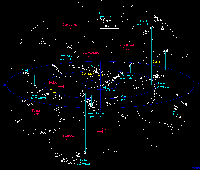 Figure 8. A graph showing the locations of
superclusters around our own (we're in the middle). This map shows the
material within about 1 billion lightyears distance from us. Image is
from Richard
Powell's website.
Figure 8. A graph showing the locations of
superclusters around our own (we're in the middle). This map shows the
material within about 1 billion lightyears distance from us. Image is
from Richard
Powell's website.
If there are clusters of galaxies and clusters of clusters, are there clusters of Superclusters?
This is getting silly, but it isn't a silly question, especially when
you look out into space and see how the superclusters are arranged out
there. It appears that there is a kind of structure to the Universe;
things are not smoothly distributed. Clusters and superclusters tend to
be grouped together. When we map out large areas of the sky and look at
the distances and locations of galaxies, clusters of galaxies and
superclusters of galaxies, we see some very large scale structure in our
Universe. The image below is from a survey of the sky in two directions
from the Earth. Notice how many bubbles and holes there are in the
image - stuff is clumpy!
There are regions with very little matter (called voids) and other regions with large
concentrations of galaxies (superclusters or even clusters of
superclusters). Matter isn't evenly spread out but appears to be rather
clumpy. This is an important characteristic of the Universe that we'll
run into it later. There are many surveys that are mapping out this
structure to our Universe (often refered to as Large Scale Structure)
and the results from the various surveys are consistent - the Universe
isn't smooth!
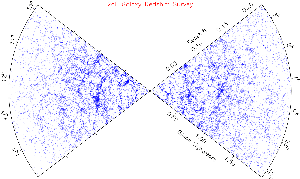 Figure
9. A graph of around 220,000 galaxies
surveyed in two directions of the sky. The Earth is in the middle of
the wedges. Each dot represents a galaxy. To be precise, the sizes of
the dots are much too large (not to scale), so there is really not as
much crowding in the distribution of galaxies. With this in mind it is
obvious that the galaxies aren't uniformly spread out but clumped
together in superclusters or even larger scale features. There are also
many regions where there are no galaxies, which are very empty
stretches of space. Click on this image to get the larger version of
it. Picture is from the 2dF Galaxy Redshift Survey.
Figure
9. A graph of around 220,000 galaxies
surveyed in two directions of the sky. The Earth is in the middle of
the wedges. Each dot represents a galaxy. To be precise, the sizes of
the dots are much too large (not to scale), so there is really not as
much crowding in the distribution of galaxies. With this in mind it is
obvious that the galaxies aren't uniformly spread out but clumped
together in superclusters or even larger scale features. There are also
many regions where there are no galaxies, which are very empty
stretches of space. Click on this image to get the larger version of
it. Picture is from the 2dF Galaxy Redshift Survey.
Now that you've read this section, you should be able to answer these questions....
- What makes Hubble Law such an important discovery?
- What does the value of the Hubble Constant tell us?
- What methods do astronomers use to determine the mass of galaxies, and what are the limitations of those methods?
- What is the significance of the Mass-to-Luminosity ratio?
- What influence does angular momentum have on the evolution of galaxies and the formation of various galaxy types?
- What role does cannibalism play in galaxy evolution?
- How large is our local galaxy cluster? What are the major members in the cluster?
- What are the possible types of dark matter?
- What evidence exists in galaxy clusters that indicate the presence of dark matter?
- What is a supercluster?
- What is the general structure of the distribution of galaxies in the Universe?
 Figure 1. A Hubble Diagram, simply a plot of galaxy
velocity versus galaxy distance. This diagram is based upon distances
found using Supernovae. The slope of the line gives the value for the
Hubble Constant, Ho. Data from Riess, Press and Kirshner (1996).
Figure 1. A Hubble Diagram, simply a plot of galaxy
velocity versus galaxy distance. This diagram is based upon distances
found using Supernovae. The slope of the line gives the value for the
Hubble Constant, Ho. Data from Riess, Press and Kirshner (1996). Figure 2. Several
galaxies in a group. The motions of these galaxies about one another
can help determine their masses. Image Credit: Hubble Heritage Team
(STScI/AURA/NASA).
Figure 2. Several
galaxies in a group. The motions of these galaxies about one another
can help determine their masses. Image Credit: Hubble Heritage Team
(STScI/AURA/NASA).  Figure 4. An
image of a group of galaxies known as Stephan's Quintet. These galaxies
are interacting with one another. If you click
Figure 4. An
image of a group of galaxies known as Stephan's Quintet. These galaxies
are interacting with one another. If you click  Figure 5. A
typical galaxy cluster, in this case the Virgo cluster. This one is
rather large having a few thousand galaxies in it. Only the brightest
are visible here. Image courtesy of NOAO/AURA/NSF.
Figure 5. A
typical galaxy cluster, in this case the Virgo cluster. This one is
rather large having a few thousand galaxies in it. Only the brightest
are visible here. Image courtesy of NOAO/AURA/NSF.  Figure 7.
Figure 7.